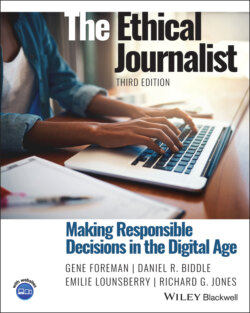Читать книгу The Ethical Journalist - Gene Foreman - Страница 57
Intervention at Central High
ОглавлениеSeptember 4, 1957, was to have been the day that 15‐year‐old Elizabeth Eckford would be among the first African American students admitted to the previously all‐white Central High School in Little Rock. But when Eckford arrived by bus at Central High that morning, she found herself the only African American in a sea of angry white people. Her path to the school was quickly blocked by the raised rifles of National Guardsmen, who had been sent by Governor Orval E. Faubus ostensibly to prevent disorder.
Eckford and the eight other African American students turned away later that morning would earn a place in history as the Little Rock Nine. Because her family did not have a telephone, she had failed to receive instructions to go to Central with the others. So, she was terrified and alone as she sat on a bench awaiting a bus to take her away from a jeering crowd that appeared to be on the verge of a riot.
In different ways and for very different reasons, two journalists intervened in the event they were covering.
Robert Schakne, a CBS News television and radio reporter, discovered that his network’s cameras had not captured the yelling and Confederate flag‐waving as Eckford walked the distance of a city block to the bus stop. What Schakne did next was described by Gene Roberts and Hank Klibanoff in The Race Beat, the Pulitzer Prize‐winning history of the news media’s coverage of the civil rights movement:
He did something that revealed the raw immaturity of this relatively new medium of newsgathering: he ordered up an artificial retake. He urged the crowd, which had fallen quieter, to demonstrate its anger again, this time for the cameras. “Yell again,” Schakne implored as his cameraman started filming.The television reporter had carried journalism across a sacrosanct line. … [H]ere in Little Rock, where a domestic confrontation of unsurpassable importance was unfolding, where journalistic propriety and lack of it were being put on public display, reporters who were inches from the drama found themselves making up the rules as they went along and doing it in front of everyone in a volatile situation with a hot, erratic new technology.18
The second journalist to intervene was reporter Benjamin Fine of The New York Times. Roberts and Klibanoff wrote that, as Fine observed tears stream down Eckford’s cheeks behind her sunglasses, he
began thinking about his own fifteen‐year‐old daughter. His emotions carried him beyond the traditional journalistic role of detached observer. He moved toward Eckford and sat beside her. He put his arm around her, gently lifted her chin, and said, “Don’t let them see you cry.”
Soon afterward, a white woman named Grace Lorch, whose husband was a teacher at a local college for African Americans, joined Fine and Eckford. When the girl boarded a bus a few minutes later, Lorch went with her.
Fine’s effort to comfort Eckford, the authors of The Race Beat wrote,
was seen by many around him as humane but completely inappropriate and probably provocative. [Fine] had inserted himself into a live story – only to remove himself from it when he wrote about the day’s events a few hours later for The Times.19
Other reporters at the scene felt compassion for Eckford, too. Jerry Dhonau and Ray Moseley of the Arkansas Gazette and Paul Welch of Life magazine arranged themselves in an informal protective cordon around her as she sat at the bus stop. “It was all that they, as professionals, felt they could do,” David Margolick wrote a half‐century later on VanityFair.com.20
For her part, Elizabeth Eckford appreciated Fine’s gesture. When a photograph of the scene outside Central High was published by The New York Times in 2018, the journalist’s daughter, Carla Fine, wrote in a letter to the editor that she met Eckford at a 50th anniversary event in 2007, and Eckford had signed a copy of the photograph for her. The inscription: “Benjamin Fine stepped out of his role as a reporter and gave his humanity to me as a gift when I had been terrorized.”21
